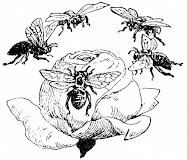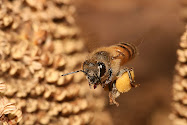


- - - and here is a little bit of info on WHS for any readers unfamiliar with the school's proud history:
From : http://www.post-gazette.com/pg/07050/763271-53.stm
Wall of Fame Extols Westinghouse High Grads
Monday, February 19, 2007
~ photo by Steve Mellon, Post-Gazette

Valeria Williams is the organizer and creator of the Westinghouse High School Wall of Fame, a photographic display of some of the great students and teachers who walked through the school.
By Ervin Dyer, Pittsburgh Post-Gazette
There, sitting in front of a piano, is Billy Strayhorn, the jazz musician who recorded with Duke Ellington; there's Chuck Cooper, one of the first black NBA players, aiming for a basket; and Naomi Simms, one of the country's first black supermodels, as sharp as she wants to be.
They are among the nearly 100 photographs that line the main hallway of Westinghouse High School. All are members of the Westinghouse Wall of Fame, a collection of alumni who have gone on to bright lights, big dreams.
Before they made it, at one point, whether in bobby socks or sky-high afros, they walked the halls of the mystical, memorable, magical ol' Westinghouse High, a place they affectionately referred to as the 'House. When they left, they gained local, national or worldwide recognition in sports, politics, music, business, social justice and education, often breaking barriers as they went.
The Westinghouse stars have lined the hall since about 1991.
About five years later, alumni Valeria Williams, Tommy Tucker and John Brewer created the Westinghouse High School Commission of Recognition to find and honor the classmates they'd heard about growing up.
Ms. Williams, class of 1967, began her research in the 1990s, the height of gang activity in Pittsburgh, and was deeply concerned about the crime and negative images that daily touched students' lives.
So, she pored over yearbooks, going all the way back to 1913, determined to present the students with more positive images.
It's a wonderful idea, said then-Principal Lester Young. "Fill every wall in the place."
And, so she tried to.
Ms. Williams gathered a world of achievers.
She found jazz legends such as Erroll Garner, Ahmad Jamal and Dakota Staton. She found Tuskegee airmen. She found actors and singers and professional football players. She found millionaires and dedicated, sacrificing community workers.
The list of names stretches from 1918 to 1991. Some classes ruled -- the wall is full of students from '51 and '52.
She found fathers and sons, such as Bill Nunn Sr., a civil rights activist and first black football player at Westinghouse, and his son, Bill Nunn Jr., one of the first black football scouts.
She found husbands and wives, high school sweethearts such as Elaine Casey and Erroll B. Davis, who trail-blazed in education and business. She found brothers and sisters: the Sloan family had Bev, Doris, Joann and Linnwood, a national radio reporter, two community service stalwarts and an arts leader.
In their cheerleader uniforms, she found Esther Bush, head of the Pittsburgh Urban League, and Carolyn Bright Smith, the mother of actor Will Smith. The youngest on the wall are twins Keith and Karl Edmonds, nationally recognized gospel mimes. They graduated in 1991.
"I thought the kids needed to see something positive," she said. "Some of these folks started off even worse than these kids had it."
The folks on the wall, she said, survived poverty, broken homes and troubles at school but they made it.
"I thought if the kids knew that these people on the wall lived in the same community, in the same houses that they do, it could make a difference."
The wall offers a mirror into yesteryear.
It harks back to a sepia-toned innocence when students took their class photographs in their Sunday best.
Their backs are straight, their clothes are starched, their eyes are fixed on a dream. They are the beautiful children who breathed in the lessons that in a world of segregation they would have to work twice as hard to go half as a far.
The 'House was packed with pride. Built in 1917 to honor the industrial engineer George Westinghouse, the hulking stone building first opened its doors to the wealthy white students who once lived in Homewood.
At its height, there were more than 1,500 students in the school. Its football team, the Bulldogs, chomped its way to championship after championship. Before shifting economics transformed it into a mostly black school, it was a model of integration for the African Americans and Italians who went there.
Ms. Williams said her classmates grew up in a wonderful time with strong teachers and heady expectations.
By most accounts, the bloom has faded.
A favored principal has retired. Enrollment has fallen to about 600 students and state reports reveal that students lag behind their counterparts in reading and math. In 2003, 40 percent of its seniors did not graduate.
Though the school was threatened with closure a few years ago, the community has not given up on Westinghouse.
There are special programs in culinary arts, cosmetology, finance and math and science to reach out to students. And, if students ever feel down, all they need to do is look at the wall to understand that they, too, can beat the odds.
Each face that hangs there offers a profile in courage.
While not all the faces are household names, each tells a story about a community of individuals -- doctors, lawyers, social activists -- who did not give up.
The glamorous Ms. Simms once bought her clothes at the Goodwill. Now, she's an Oprah Legend recognized for breaking ground in modeling.
Helen Faison, the first black (interim) superintendent of the Pittsburgh Public Schools, often shares the story of how her Homewood neighbors collected bus fare for her to commute to the University of Pittsburgh after her family was hit hard by paying some of the estimated $100 in tuition each semester.
Perhaps most inspiring is the story of Hal Brown. He lived in an East Liberty home with a dirt floor and had to go to work at 13 to help his family.
At one point, he worked five jobs. He got his big break in radio when a WAMO employee heard his mellifluous voice and suggested he be a deejay. His radio show became one of the station's most popular and he used his platform to rail against drug pushers. He later went to television, where he was an advocate for minority hiring. He never forgot the 'House and came back often to encourage a generation of journalists who came after him.
Now 73 and living in Florida, he confessed he thinks Westinghouse students believe the faces on the wall had so much help.
"But we had less opportunity than they do," he said. "There were no riots in my day by someone trying to push open doors. There was no Martin Luther King."
What the students had then, he said, "was pride and the fact that we loved each other."
- - - And here are some 2010 candidates-in-the-making for that very same Westinghouse High School Wall of Fame!

- - - click on photo for full-screen view
From left to right: Sonnikqua McKamey, Muzz Meyers, Kiyona Banks, Tobias Bullock, Kandace Cooper, Kijev James, and in front - Valerie Broughton



No comments:
Post a Comment